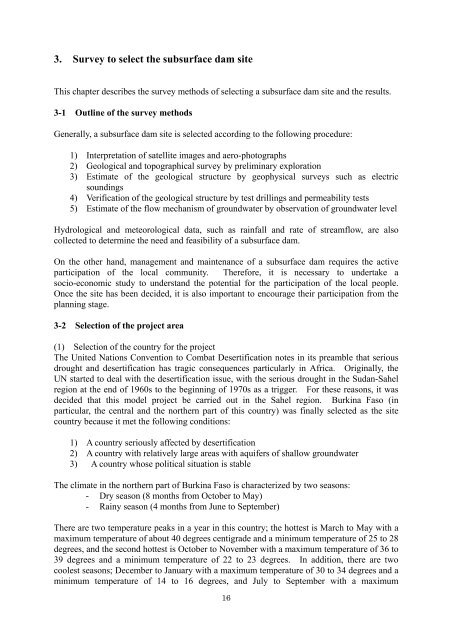SubSurface Dams - Sustainable Sanitation and Water Management ...
SubSurface Dams - Sustainable Sanitation and Water Management ...
SubSurface Dams - Sustainable Sanitation and Water Management ...
You also want an ePaper? Increase the reach of your titles
YUMPU automatically turns print PDFs into web optimized ePapers that Google loves.
3. Survey to select the subsurface dam siteThis chapter describes the survey methods of selecting a subsurface dam site <strong>and</strong> the results.3-1 Outline of the survey methodsGenerally, a subsurface dam site is selected according to the following procedure:1) Interpretation of satellite images <strong>and</strong> aero-photographs2) Geological <strong>and</strong> topographical survey by preliminary exploration3) Estimate of the geological structure by geophysical surveys such as electricsoundings4) Verification of the geological structure by test drillings <strong>and</strong> permeability tests5) Estimate of the flow mechanism of groundwater by observation of groundwater levelHydrological <strong>and</strong> meteorological data, such as rainfall <strong>and</strong> rate of streamflow, are alsocollected to determine the need <strong>and</strong> feasibility of a subsurface dam.On the other h<strong>and</strong>, management <strong>and</strong> maintenance of a subsurface dam requires the activeparticipation of the local community. Therefore, it is necessary to undertake asocio-economic study to underst<strong>and</strong> the potential for the participation of the local people.Once the site has been decided, it is also important to encourage their participation from theplanning stage.3-2 Selection of the project area(1) Selection of the country for the projectThe United Nations Convention to Combat Desertification notes in its preamble that seriousdrought <strong>and</strong> desertification has tragic consequences particularly in Africa. Originally, theUN started to deal with the desertification issue, with the serious drought in the Sudan-Sahelregion at the end of 1960s to the beginning of 1970s as a trigger. For these reasons, it wasdecided that this model project be carried out in the Sahel region. Burkina Faso (inparticular, the central <strong>and</strong> the northern part of this country) was finally selected as the sitecountry because it met the following conditions:1) A country seriously affected by desertification2) A country with relatively large areas with aquifers of shallow groundwater3) A country whose political situation is stableThe climate in the northern part of Burkina Faso is characterized by two seasons:- Dry season (8 months from October to May)- Rainy season (4 months from June to September)There are two temperature peaks in a year in this country; the hottest is March to May with amaximum temperature of about 40 degrees centigrade <strong>and</strong> a minimum temperature of 25 to 28degrees, <strong>and</strong> the second hottest is October to November with a maximum temperature of 36 to39 degrees <strong>and</strong> a minimum temperature of 22 to 23 degrees. In addition, there are twocoolest seasons; December to January with a maximum temperature of 30 to 34 degrees <strong>and</strong> aminimum temperature of 14 to 16 degrees, <strong>and</strong> July to September with a maximum16
















